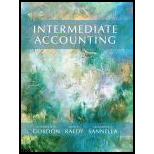
Intermediate Accounting
1st Edition
ISBN: 9780132162302
Author: Elizabeth A. Gordon, Jana S. Raedy, Alexander J. Sannella
Publisher: PEARSON
expand_more
expand_more
format_list_bulleted
Question
Chapter 7, Problem 7.3BE
To determine
The future value of the given investment.
Expert Solution & Answer
Want to see the full answer?
Check out a sample textbook solution
Students have asked these similar questions
Solution please
Given the solution and accounting question
Please provide the accurate answer to this general accounting problem using valid techniques.
Chapter 7 Solutions
Intermediate Accounting
Ch. 7 - Prob. 7.1QCh. 7 - Prob. 7.2QCh. 7 - If interest is compounded more than once a year,...Ch. 7 - Prob. 7.4QCh. 7 - Can an ordinary annuity table be used to determine...Ch. 7 - Prob. 7.6QCh. 7 - Is the present value of an ordinary annuity more...Ch. 7 - Prob. 7.8QCh. 7 - Simple Interest. Assume Shafer Corporation...Ch. 7 - Compound Interest. Assume Shafer Corporation...
Ch. 7 - Prob. 7.3BECh. 7 - Prob. 7.4BECh. 7 - Prob. 7.5BECh. 7 - Present Value of a Single Sum, Compound Interest....Ch. 7 - Future Value of a Single Sum, Compound Interest....Ch. 7 - Prob. 7.8BECh. 7 - Present Value of a Single Sum, Compounded Interest...Ch. 7 - Prob. 7.10BECh. 7 - Present Value of a Single Sum, Calculating Time...Ch. 7 - Future Value of an Ordinary Annuity. An...Ch. 7 - Future Value of an Annuity Due. Mariah Carey...Ch. 7 - Future Value of an Ordinary Annuity: Calculating...Ch. 7 - Present Value of an Ordinary Annuity. CB...Ch. 7 - Present Value of an Annuity Due, Semiannual...Ch. 7 - Prob. 7.17BECh. 7 - Ordinary Annuity, Annuity Due, Using Interest...Ch. 7 - Prob. 7.2ECh. 7 - Prob. 7.3ECh. 7 - Prob. 7.4ECh. 7 - Prob. 7.5ECh. 7 - Prob. 7.6ECh. 7 - Prob. 7.7ECh. 7 - Future Value of an Ordinary Annuity, Future Value...Ch. 7 - Single Sum, Solving for Other Variables. Two...Ch. 7 - Ordinary Annuity, Solve for Interest Rate,...Ch. 7 - Present Value, Note Payable Prices. Wiz Khalifa...Ch. 7 - Future Value of a Deterred Annuity. Lenny Shafer...Ch. 7 - Prob. 7.13ECh. 7 - Present Value of an Ordinary Annuity, Present...Ch. 7 - Prob. 7.15ECh. 7 - Prob. 7.16ECh. 7 - Future Value of an Annuity Due, Decision Making....Ch. 7 - Prob. 7.18ECh. 7 - Prob. 7.19ECh. 7 - Prob. 7.20ECh. 7 - Prob. 7.21ECh. 7 - Prob. 7.22ECh. 7 - Prob. 7.1PCh. 7 - Present Value, Present Value of an Ordinary...Ch. 7 - Present Value, Present Value of an Annuity Due,...Ch. 7 - Prob. 7.4PCh. 7 - Prob. 7.5PCh. 7 - Prob. 7.6PCh. 7 - Prob. 7.7PCh. 7 - Present Value of an Annuity Due, Deferred...Ch. 7 - Present Value of an Ordinary Annuity, Present...Ch. 7 - Future Value of an Ordinary Annuity, Deferred...Ch. 7 - Present Value, Present Value of an Ordinary...Ch. 7 - Prob. 7.12PCh. 7 - Prob. 7.13PCh. 7 - Expected Cash Flows. Hiteck Electronics sells a...Ch. 7 - Prob. 7.15P
Knowledge Booster
Similar questions
- Please provide correct solution and accounting questionarrow_forwardQuestion 10 of 12 View Policies - / 12.5 III ⠀ Current Attempt in Progress During 2025, Wildhorse Company incurred the following direct labor costs: January $26,000 and February $39,000. Wildhorse uses a predetermined overhead rate of 120% of direct labor cost. Estimated overhead for the 2 months, respectively, totaled $25,350 and $46,410. Actual overhead for the 2 months, respectively, totaled $32,500 and $43,550. Calculate overhead applied. January February $ Determine if overhead is over- or underapplied for each of the two months and the respective amounts. January $ February $ Save for Later Attempts: 0 of 1 used Submit Answerarrow_forwardCan you help me solve this general accounting problem using the correct accounting process?arrow_forward
- Does digital accounting eliminate the need for Internal Control or does digital accounting further enhance the need for Internal Control? What challenges do auditors face while understanding the Internal Control where the company's accounting system is highly digitalized?arrow_forwardHiarrow_forwardChoice correctarrow_forward
arrow_back_ios
SEE MORE QUESTIONS
arrow_forward_ios
Recommended textbooks for you
- Principles of Accounting Volume 2AccountingISBN:9781947172609Author:OpenStaxPublisher:OpenStax College

Principles of Accounting Volume 2
Accounting
ISBN:9781947172609
Author:OpenStax
Publisher:OpenStax College